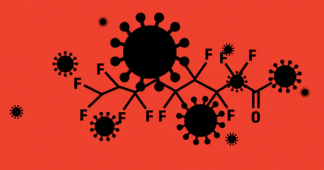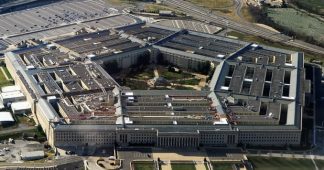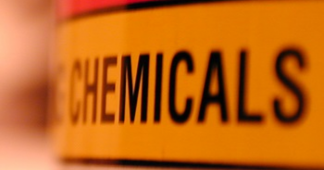“The U.S. military is supposedly there to protect people. It does the opposite.”
By Brett Wilkins
As the U.S. military continues construction of a controversial new base at Henoko Bay, Okinawa, the recent discovery of extreme levels of highly toxic “forever chemicals” in local waterways and groundwater has renewed long-standing opposition to the American occupation of large portions of the Japanese archipelago.
The Asahi Shimbun reported Tuesday that water quality checks near U.S. bases in Okinawa found “alarming” levels of perfluorooctane sulfonic acid (PFOS) at 38 locations, or more than 70% of tested sites.
More than 1,000 nanograms of PFOS and other substances per liter of water—or 20 times higher than the Japanese Environment Ministry’s provisional target of 50 nanograms per liter—were detected at eight sites near two U.S. bases. Groundwater collected from below a private home in Kadena town tested at 2,300 nanograms per liter of PFOS and other substances, or 46 times higher than the government target.
“The U.S. military is supposedly there to protect people. It does the opposite,” said Jon Reinsch, a Seattle-based writer specializing in American bases in Okinawa. “Imagine the uproar if China were responsible for this PFOS contamination. But since the U.S. is to blame, it will be swept under the rug.”
PFOS exceeds state-set levels at 38 sites near US bases in Okinawa
The US military is supposedly there to protect people. It does the opposite.https://t.co/rjbWYBoFDs— Jon Reinsch (@JonReinsch) December 28, 2021
Commonly called “forever chemicals” because they do not biodegrade and accumulate in the human body, per- and polyfluoroalkyl substances (PFAS)—which include PFOS, PFOA, and GenX—have many uses, from nonstick cookware to waterproof clothing to firefighting foam.
According to the U.S. Agency for Toxic Substances and Disease Registry, PFAS is linked to cancers of the kidneys and testicles, low infant weight, suppressed immune function, and other adverse health effects.
A study published in October by the Environmental Working Group (EWG) found nearly 42,000 potential sources of PFAS that could contaminate drinking water throughout the United States. Additionally, EWG reported in August that Pentagon documents showed at least 385 U.S. military facilities nationwide are contaminated with PFAS.
In Okinawa, elevated PFAS levels have been detected in waterways, soil, residents’ blood, and the drinking water consumed by 450,000 people.
#テレメンタリー 2021#見えない侵入者 〜米軍基地から漏れ出す永遠の化学物質〜
英語版公開Forever Chemicals – How the US military contaminated the drinking water for 450,000 Okinawans#QAB #沖縄 #Okinawa #PFOS #PFOA #PFAS #pollutionhttps://t.co/bEQ2bTjTxq
— QAB琉球朝日放送【公式】 (@QAB_official) August 17, 2021
In August, the U.S. Marines at Air Base Futenma defied a desist order from local authorities and dumped 64,000 liters of PFOS-contaminated water into the public sewer system, an act that sparked protests and drew condemnation from the Okinawan and Japanese governments. The toxic wastewater was produced during firefighting drills using foam containing PFOS and other hazardous chemicals. Cleanup costs, expected to run around U.S. $800,000, will be shouldered by the Japanese government.
“We are at a loss for words at the erratic attitude and behavior of the U.S. forces stationed in Okinawa Prefecture,” Asahi Shimbun editors wrote at the time. “The act is downright impermissible… The U.S. forces’ high-handed manner will only deepen the rift between themselves and the Okinawans and entrench the latter’s mistrust into something indelible.”
That mistrust is as old as the U.S. military presence in Okinawa, which was conquered during the closing months of World War II at the cost of over 100,000 civilian lives.
Since then, U.S. troops—who occupy 31 bases in an archipelago roughly half the land area of Long Island—have committed thousands of crimes, including dozens of alleged murders and over 120 alleged rapes, often with impunity due to a status of forces agreement (SOFA) written by Americans for their own protection.
U.S. military forces have also fired and lost nuclear weapons in local waters, leaked the deadly nerve agent sarin, and exposed residents to chlorine gas, to name but a handful of the most egregious environmental incidents over the decades.
Although the 1995 gang-rape of a 12-year-old girl by two Marines and a sailor led to a revision of the U.S.-Japan SOFA so that Japanese authorities could convict and imprison Americans who commit the most heinous offenses—a development that led to scores of convictions—crimes against Okinawans and the local environment continue to this day.
“Japanese officials are kept totally in the dark about what amount of toxic materials [Americans] possess and how they are administering those substances,” the Asahi Shimbun editors wrote. “That is because the supervisory authority over U.S. military bases in Japan lies with the U.S. forces under the status of forces agreement. A supplementary agreement on environmental stewardship took effect in 2015, but the competence of Japanese authorities in that field remains ambiguous.”
Peace groups have pointed to toxic contamination as one of the numerous reasons to halt construction on the relocated Futenma air base at Henoko Bay.
“The U.S. military recently began releasing toxic chemicals (PFAS / PFOS) into Okinawa's water supply, despite outcry and protest from Uchinanchu at every level, including Okinawan government officials.” #ClimateJustice #BuildBackFossilFree https://t.co/ntkbE6avII
— CODEPINK (@codepink) October 14, 2021
“This new base will wreak havoc on the environment, violate human rights, oppress Indigenous Luchuans, and desecrate the dignity of war victims (including Indigenous Okinawan civilians and American, Okinawan, Japanese, and Korean soldiers) whose remains are believed to reside in the soil being used by the U.S. to fill the ancient coral reef of Henoko,” CodePink says in a petition urging the Biden administration to immediately end construction on the facility.
Published atwww.commondreams.org
We remind our readers that publication of articles on our site does not mean that we agree with what is written. Our policy is to publish anything which we consider of interest, so as to assist our readers in forming their opinions. Sometimes we even publish articles with which we totally disagree, since we believe it is important for our readers to be informed on as wide a spectrum of views as possible.











